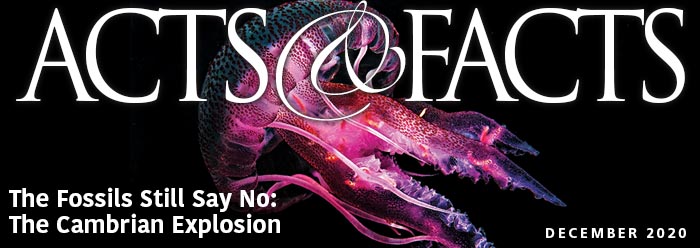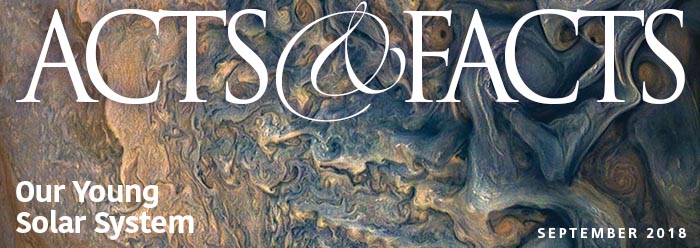Secular astrophysicists often talk about “primordial nucleosynthesis” as though it were a historical event like Washington crossing the Delaware. In theory, it describes how certain conditions—not God’s handiwork—during an early Big Bang universe somehow cobbled together the first elements. However, unlike Washington’s crossing, no historical evidence corroborates this primordial nucleosynthesis, an idea beset by a theoretical barrier called the “lithium problem.” Secular scientists recently put this problem to a practical test.
In theory, the Big Bang’s natural processes would have produced a certain ratio of stable lithium isotopes—lithium-6 and lithium-7. Michael Anders of the Helmholtz-Zentrum Dresden-Rossendorf (HZDR) used the LUNA accelerator, sheltered from solar radiation beneath thousands of feet of Italian mountain rock, to test that theory. The device flung helium nuclei at deuterium nuclei to form lithium-6 in conditions designed to mimic those that characterized the Big Bang’s supposed primordial nucleosynthesis.
Unfortunately for Big Bang theorists, their experiment succeeded. The details, published in Physical Review Letters, demonstrated that if lithium actually formed by some primordial nucleosynthesis, it should indeed have formed in the predicted ratio.1
And that’s a big problem for the Big Bang.
The lithium problem centers on an early Big Bang universe that would have generated the first atoms like helium and lithium in certain ratios. But the areas of outer space that secularists associate with that early time show at best only half the predicted amounts of lithium-7.
Put simply, the universe has way too much lithium-6 than the Big Bang could produce.
An HZDR press release said, “With these new results, what is known as the ‘lithium problem’ remains a hard nut to crack.”2 Hard indeed—where did all the Big Bang’s lithium-7 go?
One way to solve the lithium problem is to jettison the Big Bang theory altogether. Actually, that would fix a long list of problems: the horizon problem,3 mature distant galaxy problem,4 dark matter problem,5 flatness problem,6 missing antimatter problem,7 young spiral galaxy problem,8 inflation ignition problem,9 asymmetry problem,10 and star formation problem.11
As science progresses, one would think it would increasingly confirm theories like the Big Bang. But instead of solving the Big Bang’s many problems, scientists are only finding more of them. The Big Bang theory has been imploding for decades as scientific experiments and observations continue to confirm Big Bang deal-breakers. And if the man-made narrative of the Big Bang never really happened, then God’s narrative of universal beginnings is back on the table.
References
- M. Anders et al. 2014. First Direct Measurement of the 2H(α,γ)6Li Cross Section at Big Bang Energies and the Primordial Lithium Problem. Physical Review Letters. 113 (4): 042501.
- Measurement at Big Bang Conditions Confirms Lithium Problem. Helmholtz-Zentrum Dresden-Rossendorf press release. Posted on hzdr.de August 27, 2014, accessed August 29, 2014.
- Coppedge, D. 2007. The Light-Distance Problem. Acts & Facts. 36 (6).
- Thomas, B. Distant Galaxies Look Too Mature for Big Bang. Creation Science Update. Posted on icr.org November 30, 2011, accessed September 2, 2014.
- Hebert, J. 2013. Dark Matter, Sparticles, and the Big Bang. Acts & Facts. 42 (9): 17-19.
- Hebert, J. 2012. Big Bang Explanations Fall Flat. Acts & Facts. 41 (11): 16.
- DeYoung D. B., Ph.D. 1998. Creation and Quantum Mechanics. Acts & Facts. 27 (11).
- Humphreys, D. R. 2005. Evidence for a Young World. Acts & Facts. 34 (6): i-viii.
- Thomas, B. Inflation Hypothesis Doesn't Measure Up to New Data. Creation Science Update. Posted on icr.org January 29, 2009, accessed September 2, 2014.
- Erickcek, A. L., M. Kamionkowski, and S. M. Carroll. 2008. A hemispherical power asymmetry from inflation. Physical Review D. 78 (12): 123520.
- Lisle, J. 2012. Blue Stars Confirm Recent Creation. Acts & Facts. 41 (9): 16.
* Mr. Thomas is Science Writer at the Institute for Creation Research.
Article posted on September 22, 2014.
















